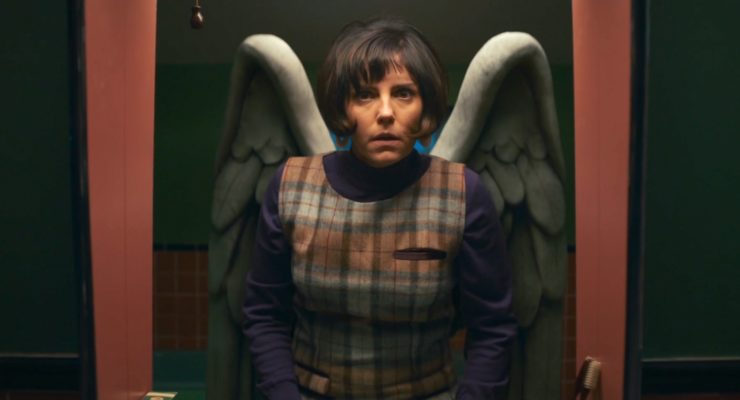Should I avoid taking any screencaps with Weeping Angels? I probably should, right? Am I going to, though?
…too late.
Recap
Claire Brown (from the first episode of the season) is talking to Professor Eustacius Jericho (Kevin McNally) in a small village called Medderton in the year 1967. He has her hooked up to machinery to monitor her brain activity as she does baseline questions, but her answers are pretty wonky—since, you know, she was actually born in 1985. Then she gives him a warning in a voice that isn’t her own. Aboard the TARDIS, the Doctor figures out how to banish the Weeping Angel, but they still wind up at the coordinates it set, which brings them to Medderton. There’s currently a search on in the village for a missing child named Peggy, and Yaz and Dan offer to help with that while the Doctor pokes about. A woman named Mrs. Hayward (Penelope McGhie) tells the local reverend (Alex Frost) to count the headstones in their cemetery, and he does, finding another Weeping Angel. He vanishes. Yaz and Dan talk to Peggy’s guardians, Gerald (Vincent Brimble) and Jean (Jemma Churchill), and find Gerald abrasive and unkind. Then they both encounter a Weeping Angel, and their torch goes out.
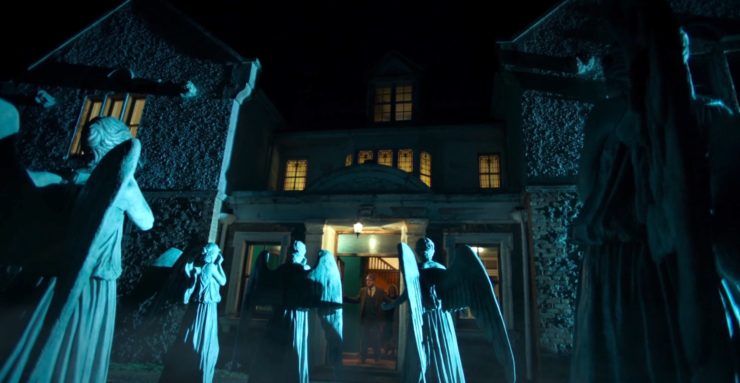
The Doctor meets Professor Jericho and Claire (again). There’s a drawing of an angel she’s done, which the Doctor promptly rips up. Angels surround the professor’s house, so the Doctor tries to set up a perimeter to keep them safe using a phone camera that she’s hooked into an old television set, so someone can watch the angels breaking into the house. It turns out that the reason why Claire recognized the Doctor and Yaz in 2021 is because she’s a psychic and had premonitions of this whole thing. She did some research on this town ahead of time, which also showed up in her visions, and learned that the entire town disappeared tonight in 1967… but that it also happened in this same town in 1901, and people think the place is cursed. Claire keeps having strange physical reactions—dust in her eye, wings at her back—as the Doctor realizes that an angel is camping out in her brain. She asks if she can enter Claire’s mind and talk to it to find out what’s going on while Jericho keeps watch for them.
Yaz and Dan wind up in 1901 and find the town deserted, except Peggy, who says the Weeping Angels left messages in her mind, including that they promised to leave her alone… because they like to leave witnesses to the cruelty they commit. Dan wants to know if they’re stranded here, and Yaz can’t answer that question. They come across Gerald and Jean, who have also been transported there, but Gerald arrogantly crosses the path of the angel so no one can keep an eye on it, and he and Jean are both killed. The borders of the town only show stars beyond. Peggy takes Dan and Yaz toward an old burial ground she says they found when she was young because there’s something wrong with the place; when they arrive, they find a division in space-time, with 1967 on the other side. No one can step through without disintegrating. They see Mrs. Hayward on the other side and learn that she’s Peggy as an older woman, having lived out the rest of her life through the past.
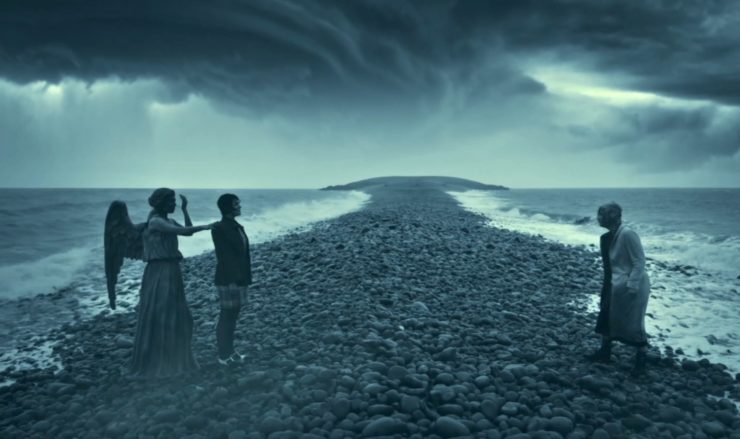
The Doctor meets the angel in Claire’s mind and learns that it is responsible for bringing her here; it wants her to protect it from this squad of Weeping Angels because they’re all Division, and it claims to have knowledge of all their missions and the Doctor’s missing history. The Doctor tries to help Jericho and Claire escape the basement of Jericho’s house, but they’re everywhere. Suddenly, they stop pursuing; the Doctor exits to find herself surrounded by Weeping Angels and 1901 and her friends across the way; Jericho has been transported to 1901 as well. The angel inside Claire explains that this was actually a trap to exchange her for itself—Division is more keen to get its hand on her anyhow. The Doctor is transformed into an angel and then teleported away with the Weeping Angel extraction squad.
In another place and time, Bel arrives at Puzano, one of the only planets left with survivors from the Flux. As she’s looking for Vinder, she comes across a man named Namaca (Blake Harrison), who tells her that someone comes to rescue survivors every so often. This turns out to be Azure, who takes survivors aboard a Passenger; Bel knows what they are and forces Namaca to run with her and avoid capture. He’s dismayed and won’t leave the planet with her, but later encounters Vinder and tells him that Bel probably saved his life. He directs Vinder to a message from Bel, who is about to give him coordinates to her location when her recording cuts out from an unknown threat. Vinder vows to find her.
Commentary
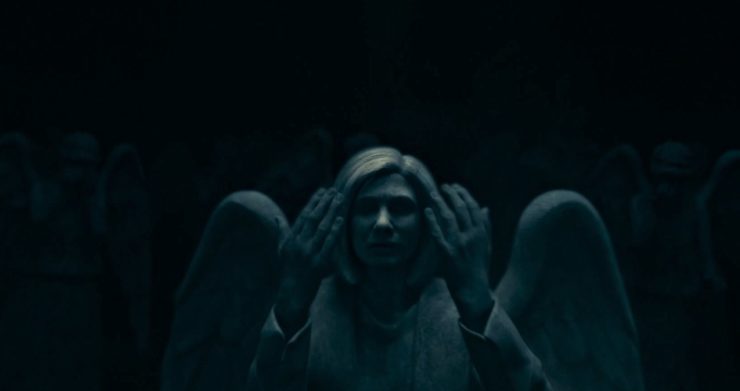
Okay, I’ve got questions, namely, turning a person into an angel isn’t how Weeping Angels get “made,” right? Because I’m okay with it being a mode of capture as long as this isn’t how Weeping Angels come into being. Then again how to do they happen? I can’t believe that they reproduce in any common biological way, so… you know, this is a lot for the ol’ brain at the moment, I’m just gonna leave that whole line of inquiry there and step right back.
It’s a pretty clever switch up having Claire be psychic because, of course, on any show with frequent time travel, you expect people meeting the Doctor and friends out of order to be a temporal kerfuffle, not a mental one. This episode does a great job of keeping things engaging around the Doctor while she’s figuring out the core mystery, which winds up being heavily tied to her. Dan and Yaz get stuck, Bel is trying to rescue people from the Ravagers, Professor Jericho went through it long before the Doctor (or Claire) ever showed up near his house, and poor Peggy has a guardian who treats her as somewhat less than human—which, pointedly, does a handy job of mirroring the Doctor’s upbringing at the hands of her own Gallifreyan guardian.

Perhaps it’s not relevant, but this Angel refers to the shadowy organization that employed them all simply as “Division,” not “the Division.” We’re also learning that they employed basically any and all species, not just Gallifreyans. The only reason I’m making note of it is because Doctor Who has a history of changing little things like that to indicate a reframing of an organization or group. (Remember when the assumption was that the Shadow Proclamation was a document or treaty and it turned out to be a bunch of folks?) So we’re obviously in for some major revelations on that front, and the word “division” might be a piece of that. Does Division essentially protect the division between time and space, or something in that arena?
Again, the Weeping Angels are properly frightening in this situation while using all the myth-building that has been done with them up to date. It’s a function of shows like Who that once you’ve encountered an antagonist a certain number of times, you don’t expect to get a lengthy explainer on them, and this episode is a great example of how you can get people up to speed on a concept like the Weeping Angels in short order very effectively. My only complaint here is that I think we should have spent more time with Mrs. Hayward; the reveal of her being Peggy is good, but it would have been better if we’d gotten to know her and cared about her more. It also would have made that reveal of the Weeping Angel not attacking her again in 1967 more of a surprise.
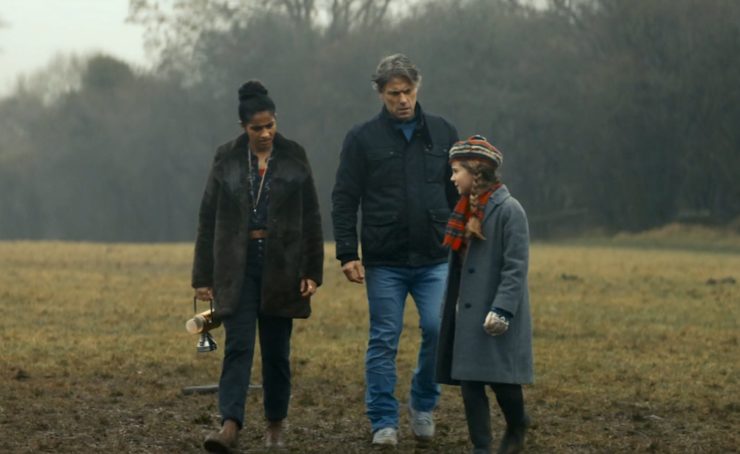
I’m really enjoying Yaz and Dan as a duo, which I wasn’t expecting. Dan’s good at going along with whatever gets thrown at him, and Yaz has reached a level of competence that rivals the Doctor in most situations; she absorbs all the surrounding material and information quickly and is very good at keeping others calm even when she herself is terrified. But I’m still missing what’s going on in her head. This is a problem that frequently comes from being a competent character who’s not the central one—not enough people are asking how you’re doing.
Also, I’m presuming that Professor Jericho is going to be the one who raises Peggy in the past, but I can’t help feeling bad for a guy who already lived through World War II having to go back and live through World War I (which he might have already lived through, depending on his age; it’s unclear here). When he talks about his past experience, he’s specifically talking about liberating a Nazi concentration camp, so his determination not to be cowed by a bunch of statues makes a lot more sense. And nothing is more British than his need to point out that the act of using his own voice to menace him is rude without permission. (Speaking of permission, the Doctor actually asks Claire if she can enter her mind, which is a step up from the usual, given how she handled poor Ada Lovelace.)
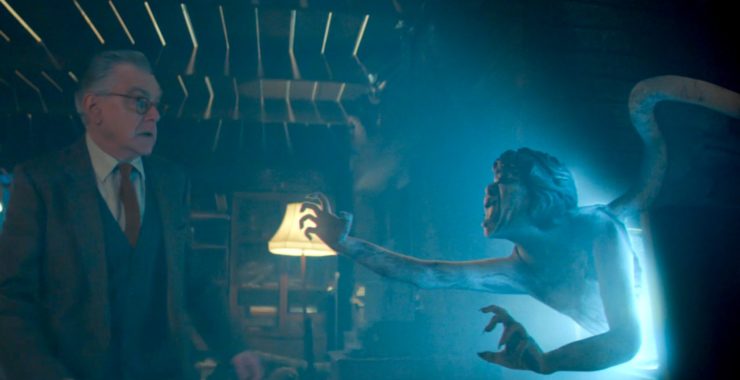
I love Bel and Vinder still, and everything is a right mess after this episode, so… the week is gonna be a long wait.
Stuff and Things
- So the Doctor does that thing she always does where she steps out of the TARDIS and looks around and sniffs the air, and goes “ah yes, we’ve arrived in [this year],” only this time she’s told she’s wrong and then wrinkles her nose at Gerald and tells him he must’ve had that coat for a proverbial age. Indicating that the coat was her primary indicator of the year when they landed. Which proves that the Doctor is always lying out their arse when they do this whole fakey I-can-smell-time thing, and I have always believed this was a con, and I love every time they suggest that.
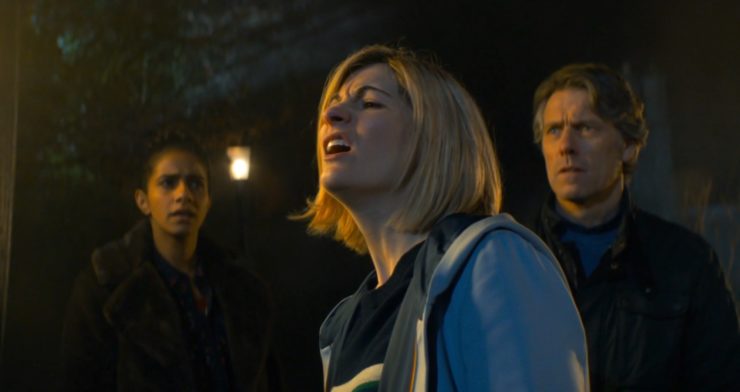
- She tied a camera to a banister with a rainbow to stop a monster. *weeps*
- This is the first time we’ve gotten an indication that if a Weeping Angel touches you twice, you die. Which makes sense, since you probably can’t get potential quantum energy off a living being twice?
- The angels leave the chickens in the 1901 town, presumably because they don’t live long enough to make a very tasty time meal.
- The last time we saw dust pouring from someone’s eye as a result of contact with the Weeping Angels, it was Amy Pond.
- I’m guessing that the starscape surrounding the village is more Flux damage? That’s probably not great for anyone currently stuck there. Guess they’re growing their own food for the foreseeable future…
See you next week with “Survivors of the Flux.”










